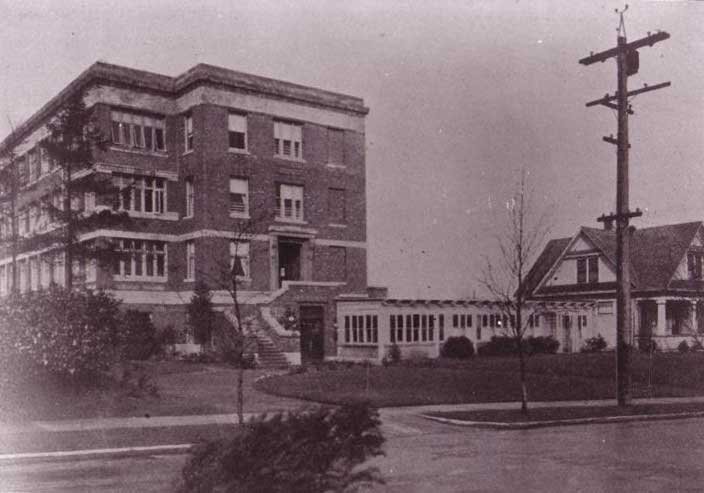Children's Hospital to Queen Anne Manor: Memories of Care become Memory Care
Hold your breath. The people and buildings in this photo tell so many great stories about Queen Anne and Seattle’s future that it practically knocks your socks off. The stories range from the role of wealthy women in creating Seattle’s civic institutions; to the importance of unions in constructing this city; and to the architects who came west to design among other buildings, places for the care of injured, sick and sometimes abandoned children.
Easily recognized by anyone who regularly walks the neighborhood, this photo shows the 1910 construction site of a local landmark. Between 1908 and 1953, Children’s Orthopedic Hospital called this block home. It is now Queen Anne Manor and serves seniors. Here, we’re looking west from Warren Ave. N. with Boston St. to the right and Crockett to the left.
The photo features three buildings -- the Fresh Air Cottage, the new hospital under construction, and the construction shack next to it -- and nine people. The nurse in white –= even in this black and white photograph, she must be in white –- works in the cottage, the Hospital’s first permanent home.
The site was selected by hospital founder Anna Herr Clise (1866-1936) and her 23-woman Board of Directors after a long search for a hilltop location on a convenient streetcar line far from the dirty downtown. It was just the location to speed the recovery of the 12 children the cottage could serve at any one time. When it opened in 1908, fresh air on breezes such as those floating up from Elliott Bay were an important part of hospital cures.
In addition to the nurse, there are eight people in this photo, five of whom are probably patients. Three of the five boys are on crutches. Another has his foot wrapped in a dark material over a cast. The boys on crutches probably had had broken legs repaired or tuberculous arthritis in their joints. (This was not an uncommon malady at the time.) Of course, they could have been treated for polio. In fact, during his successful presidential campaign, the nation’s most famous polio victim, Franklin Delano Roosevelt, stopped here in September 1932. There are no visible signs of the fifth boy’s ills, while the woman behind the hillock in dark clothes remains a mystery.
The two men on the scaffolding appear to be having lunch near the unfinished first story entrance. It will soon perch above the basement level up a curving stair that the boys on crutches would surely have a tough time navigating. The men may not be doing the brickwork, but as the sign on the constructions shed tells us, they were union men. It is easy to pick out the Flemish bond of the brick stretchers and headers just behind the men. (in Flemish bond, long and short sides of the brick alternate with the short brick centered over a long brick.) The bond suggests this is a masonry load bearing building. But it’s probably not. Through the window you may be able to pick out tough steel-reinforced concrete piers that really hold things up and had enough residual strength to support the addition of a fourth floor in 1921. When the fourth floor was completed, the hospital had 78 beds in open airy wards.
Records haven’t yet revealed who designed the top floor, but the three original ones were the work of W. Marbury Somervell (1872-1939) and Joseph S. Coté (1874-1957). Trained in the Beaux Arts tradition at Ivy League schools (Somervell, Cornell; Coté, Columbia), they provided booming Seattle with architectural symbols for its new civic institutions. The two men arrived in 1903 to supervise construction of St. James Cathedral for the New York firm of Heins & LaFarge and stayed.
In 1928, the Fresh Air Cottage was torn down when architect Abraham H. Albertson (1872 - 1964) redesigned and expanded the building. Like Coté, he trained at Columbia and came to Seattle in 1907 to prepare a development plan for the Metropolitan Tract. One of Albertson’s best-known works is the Northern Life (now Seattle) Tower (1927-29). On Queen Anne, he also did the Stuart/Balcom residence at 619 W. Comstock St. (1926), a designated city landmark; and St. Anne’s Convent (1930), 1st W. and W. Comstock.
Unlike the austere flat roof on the original building, Albertson’s addition boasts a graceful hipped roof covered with barrel shaped tiles. Terraces for the children to breathe fresh air on dry days and many windowed sun rooms are among its features. Under a triple-arched porch along Warren Ave. Albertson dressed up the new building entrance with bright terra cotta decorations including fanciful capitals each of which sports playful squirrels holding up the entablature. Sick children surely loved being welcomed by these happy critters, while colorful terra cotta plaques many with bas-relief sailing ships provided playful distractions from disquieting casts, braces and crutches.
Almost from the very beginning, hospital trustees established a policy of accepting any child, regardless of race, religion, or parents’ ability to pay. For 40 years, the school district ran Children's Orthopedic Hospital School in the buildings as an annex to John Hay Elementary.
After serving between 1953 and 1968 as a King County Health Department clinic and then for County offices and a morgue until 1980, when the building became a retirement home. Today Children’s Orthopedic Hospital is known as Queen Anne Manor, its open wards converted to private apartments. The frolicking squirrels on those Warren Ave. capitals and an expanded roof garden visible from Boston St. now cheer up ‘memory care’ patients in freshly remodeled spaces and a place named for the hospital’s founder: Anna’s Garden.





